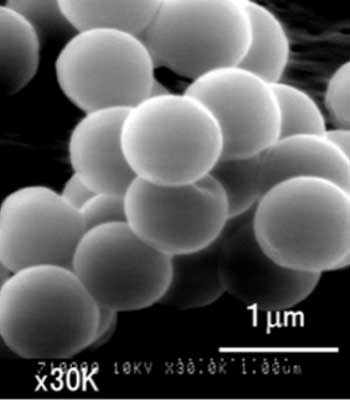Bacteria cause infections all over the world. Bacteria with acquired resistance to antibiotics pose public health problems that need urgent action. We have developed a anew antibacterial mechanism of action on the basis of bacterial structures and growth processes.
This technology is based on basic research that has thus far been conducted for a long period. In addition, it has been supported by Program for Creating Start-ups from Advanced Research and Technology (2012-2013), Ministry of Education, Culture, Sports, Science and Technology and Strategic Foundational Technology Improvement Support Operation (2012-2014), Ministry of Economy, Trade and Industry.
Using this technology thus developed, we aim to achieve “Global environment-friendly phylactic technology, production of safe food, and society of clean living and coexistence with living organisms.”
New Antibacterial Nano-particles

Nano CAME's New Technology
We focused on the cell wall of bacteria and bacterial growth process. Most bacteria have cell walls. Similar to the maintenance of the shape of human bones, bacteria has an important mechanism of maintaining their structures by keeping the internal pressure low (8 to 20 atmospheres). When bacteria keep growing, cell walls also repeat growth and reproduction.
Antibacterial Nanoparticles have a high affinity for the sugar chain peptide surface layer of the cell wall and inhibit the synthesis of the cell wall in local areas to which Antibacterial Nanoparticles have adsorbed.

The cell wall grows in the areas where Nanoparticles have not adsorbed. This causes unbalanced growth in these areas as compared to the areas to which Nanoparticles have adsorbed (location of conjugation) and makes it impossible to maintain the internal pressure, leading to autolysis.

The autolysis of Staphylococcus aureus, induced by Nano-particles (movie)
World's first technology;Nanoparticles simply attach to the cell wall
Induces autolysis of bacteria

Biodegradable antibacterial nanoparticles Electron microscope image
Staphylococcus aureus rupture(movie)
Produced by Dr. Shoichi Shirotake, previous professor of Grad. Sch. Med., Yokohama City University
Characteristics of New Technology
These nanoparticles that evoke apoptotic effects in bacteria are the first technology of its kind in the world, and we have filed an application for patent.
- It does not lead to the occurrence of resistant bacteria, and its effect is sustained.
- It does not require rare metals and ensures a stable supply.
- It ensures safety in the body and does not damage the environment.
Experimental Example
1. MIC Table
| Pathogens | MIC Results (μg/mL) | |||||
|---|---|---|---|---|---|---|
| Nano-particles D•Gly | Nano-particles D•Arg | Nano-particles D•Asp | Nano-particles D•Ala | Antibiotic ABPC | Rubbing alcohol | |
| Staphylococcus aureus | 50 | 50 | 50 | 50 | 0.25> | 15000 |
| Staphylococcus aureus | 50 | 50 | 50 | 50 | 2 | 60000 |
| Multiple drug-resistant and methicillin-resistant Staphylococcus aureus | 100 | 100 | 50 | 50 | >128 | 60000 |
| Multiple drug-resistant and methicillin-resistant Staphylococcus aureus | 50 | 50 | 50 | 50 | >128 | 60000 |
| Enterococcus | 50 | 50 | 25 | 50 | 0.5 | 240000 |
| Multiple drug-resistant and vancomycin-resistant Enterococcus | 25 | 50 | 25 | 25 | 2 | 60000 |
| Multiple drug-resistant and vancomycin-resistant Enterococcus | 25 | 50 | 25 | 25 | 1 | 120000 |
| Streptococcus (formerly milleri group) |
25 | 50 | 25 | 25 | 0.25> | 60000 |
| Streptococcus pneumonia | 12.5 | 12.5 | 12.5 | 12.5 | 0.25> | 30000 |
| Streptococcus pyogenes | 12.5 | 12.5 | 12.5 | 12.5 | 0.25> | 15000 |
| Peptostreptococcus | 6.3 | 12.5 | 6.3 | 6.3 | 0.25> | 15000 |
| Corynebacterium diphtheria | 25 | 25 | 12.5 | 12.5 | 0.25> | 15000 |
| Propionibacterium acnes | 12.5 | 12.5 | 12.5 | 12.5 | 0.25> | 60000 |
2. Induction of Autolysis of Multiple Drug-resistant VRE by Antibacterial Nano-particles (SEM × 15000)

3. Induction of Autolysis of VSE by Antibacterial Nano-polymer (SEM × 15000)














